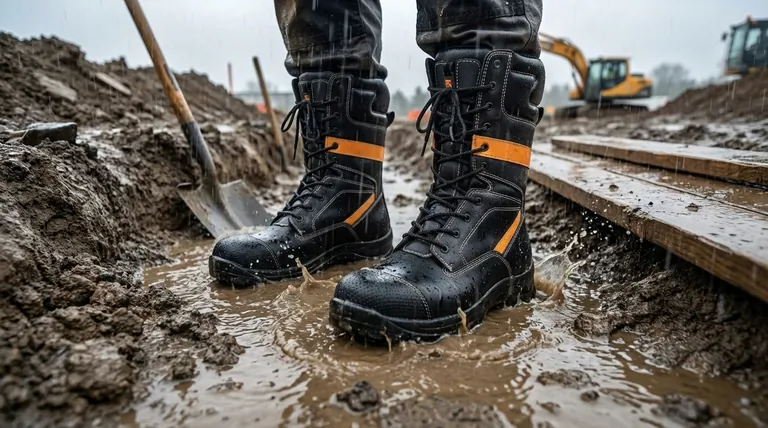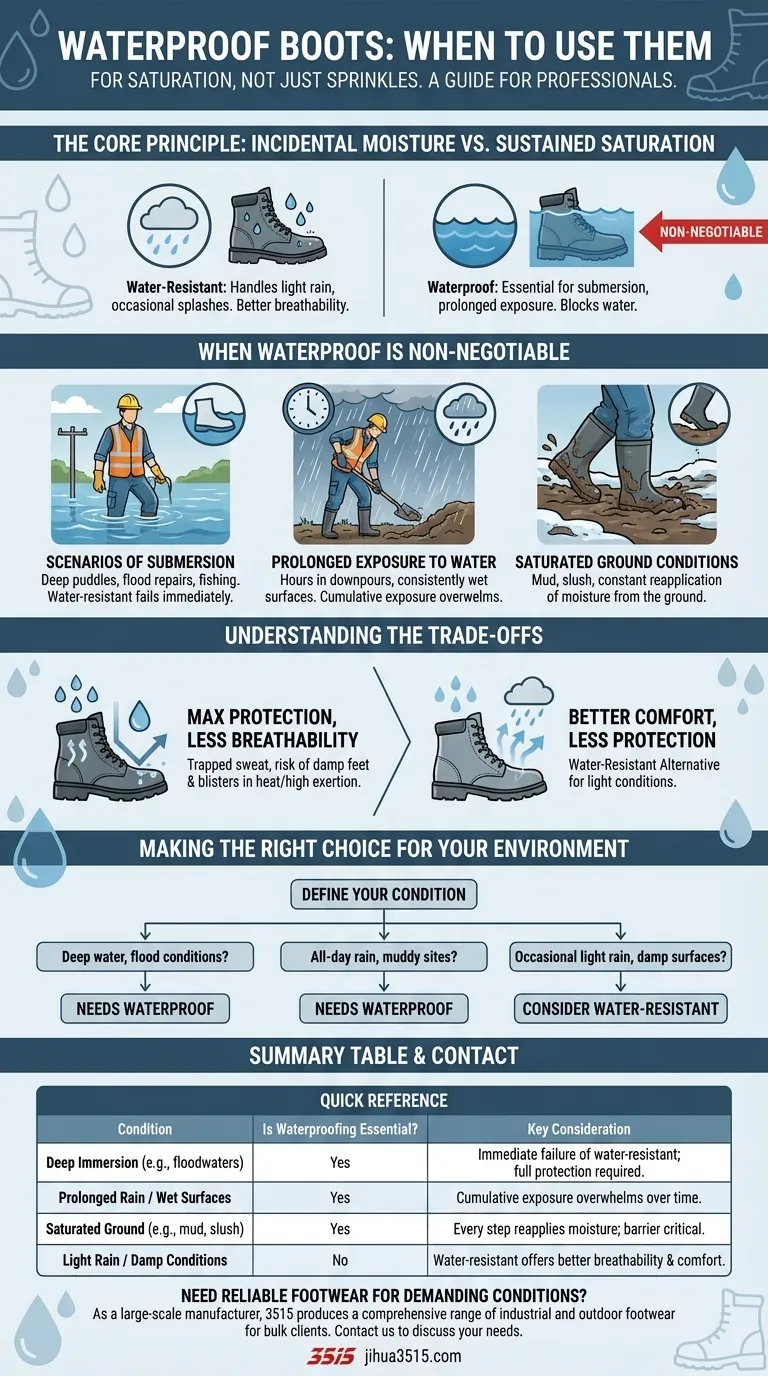I've got a pretty solid understanding of the references. The key is in boiling it down to fundamental principles. We're talking about situations where the boots are going to face sustained saturation. It's not about a few sprinkles. It's about deep puddles, floodwaters, persistent mud, and constant rain. I'm going to make sure the user understands the differences between waterproof and water-resistant. No point is mentioning how to waterproof boots; that’s outside the scope of the question.
Here's the plan:
- Hook: I'll start with a definitive statement that cuts to the chase. Something like "Waterproof boots are for saturation, not just sprinkles." The goal is to create focus and not waste time.
- The Core: I'll include a concise takeaway box that immediately clarifies the core distinction. It is a good way to organize.
- Deep Dive: Then, I'll dive into the specific scenarios where waterproofing is absolutely necessary: deep immersion, constant wetness, and fully saturated ground. Using expert-level terms, I'll explain what a user in this field can recognize and apply.
- Trade-offs: I'll include trade-offs. Breathability is the major one, that's my chance to shine as an expert. This isn't just about keeping water out; it's also about letting sweat out. I'll explain that wearing waterproof boots when it isn't needed can be a huge mistake.
- Conclusion: Finally, I'll wrap it up with a practical checklist, ensuring the reader knows what decisions to take according to different work conditions. The entire process will be logical, clear, and actionable. Waterproof boots are for saturation, not just sprinkles. They are specifically designed for conditions where your feet will be submerged in water or face prolonged, direct exposure to wetness. This includes working in deep puddles, mud, or enduring continuous rain, where lesser protection would quickly fail.
The core principle is understanding the difference between incidental moisture and sustained saturation. While water-resistant footwear can handle light rain, true waterproof boots are essential when your feet will be underwater or consistently exposed to wet environments for extended periods.

When 'Waterproof' is Non-Negotiable
The decision to use waterproof boots hinges on the intensity and duration of water exposure. Three primary scenarios make them the only appropriate choice.
Scenarios of Submersion
A boot's upper being fully submerged is the clearest indicator for needing waterproof construction. This is common in flood repairs, fishing, or navigating deep puddles on a trail or worksite.
In these cases, water-resistant materials will be immediately overwhelmed, allowing water to penetrate and saturate your socks and feet.
Prolonged Exposure to Water
Working for hours in the rain or on consistently wet surfaces requires a waterproof barrier. The cumulative effect of sustained moisture will defeat water-resistant treatments over time.
Think of activities like trench digging during a downpour, waterfowl hunting in marshes, or landscaping on perpetually damp grass.
Saturated Ground Conditions
When the ground itself is saturated with water, mud, or slush, every step reapplies moisture to your boots. Waterproofing is critical in these environments.
This is a daily reality on many construction sites, in agricultural settings, and for gardeners working in mucky soil.
Understanding the Trade-offs
While offering maximum protection from water, the technology behind waterproof boots involves inherent compromises that are crucial to understand.
The Breathability Compromise
The primary trade-off is breathability. The same membrane or construction that blocks water molecules from entering also makes it harder for the water vapor (sweat) from your feet to escape.
The Risk of Internal Moisture
In warm or dry conditions, or during high-exertion activities, this lack of breathability can trap sweat. Ironically, this can lead to damp feet, which increases the risk of blisters and discomfort.
The Water-Resistant Alternative
For environments with only light rain, drizzle, or occasional splashes, water-resistant boots often provide a better balance. They shed most moisture while offering significantly more breathability, keeping your feet more comfortable throughout the day.
Making the Right Choice for Your Environment
Selecting the appropriate footwear is about matching the tool to the specific demands of your environment and activity level.
- If your primary focus is working in deep water or flood conditions: You need a non-negotiable waterproof boot, as anything less will fail immediately upon submersion.
- If your primary focus is all-day work in rainy or muddy environments: A waterproof boot is crucial to prevent the cumulative effect of sustained exposure and keep your feet dry.
- If your primary focus is occasional exposure to light rain or damp surfaces: A water-resistant boot will likely provide better all-day comfort and breathability for your needs.
Choosing the right level of water protection is the foundation of comfort, safety, and performance in any condition.
Summary Table:
| Condition | Is Waterproofing Essential? | Key Consideration |
|---|---|---|
| Deep Immersion (e.g., floodwaters, deep puddles) | Yes | Immediate failure of water-resistant boots; full protection required. |
| Prolonged Rain or Wet Surfaces | Yes | Cumulative exposure overwhelms water-resistant treatments over time. |
| Saturated Ground (e.g., mud, slush) | Yes | Every step reapplies moisture; a waterproof barrier is critical. |
| Light Rain or Damp Conditions | No | Water-resistant boots offer better breathability and comfort. |
Need Reliable Footwear for Demanding Conditions?
As a large-scale manufacturer, 3515 produces a comprehensive range of industrial and outdoor footwear for distributors, brand owners, and bulk clients. Whether your team faces deep water, persistent mud, or heavy rain, our production capabilities encompass all types of durable waterproof boots designed for performance and comfort.
Contact us today to discuss your specific needs and discover how we can provide the right footwear solution for your business.
Visual Guide

Related Products
- Premium Flame-Retardant Waterproof Safety Boots and Shoes
- Premium High-Cut Waterproof Safety Boots Manufacturing & Wholesale Solutions
- High Performance Fire-Retardant Waterproof Safety Boots
- Factory Direct Wholesale Rain Boots Durable Waterproof & Fully Customizable
- Heavy-Duty Waterproof Nubuck Safety Boots Safety Shoes for Bulk Supply
People Also Ask
- How do some boots combine materials for better performance? Achieve Superior Safety & Comfort
- What are the signs that safety toe boots are worn out and need replacement? Ensure Your Workplace Safety
- How does repeated exposure to high temperatures damage safety boots? Avoid Costly Structural Failures
- What factors should be considered when choosing the appropriate type of safety footwear? A Guide to Maximum Protection
- What are the benefits of proper safety footwear beyond physical protection? Boost Productivity & Morale



















